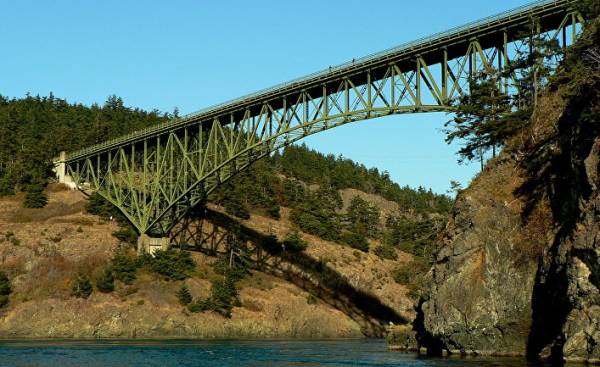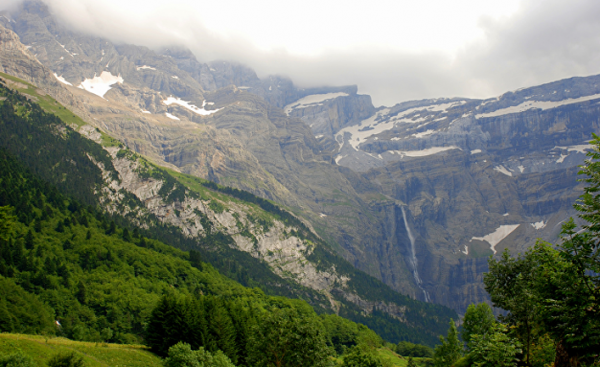
Translation carried out by the project Newочем
You ever happen to find yourself in located on a high altitude place and to feel an irresistible urge to jump? This is the feeling that one fine day experienced Judith Dancoff, standing in the middle of the bridge, “Deceptive way” — a narrow dvupolnoj jumper, connecting the two Islands North of Seattle. She followed this impulse — and it would be guaranteed death at the bottom of the ocean.
Judith is a writer, known in the literary world for his flights of fancy — not seen a dramatic impulse to commit suicide, she never had such desires. Of course, she, like many, was afraid of heights, but at that moment, strangely, she felt no fear, although the “Fraudulent way” is considered one of the scariest bridges in the world. Flimsy concrete structure stretches over the pointed tops of the hills, as they say, dangles from side to side in windy weather. Only in 1935 the railing separating the passengers from the hustle and bustle under the bridge the muddy water of the ocean.
None of this came to mind, Dankoff also not suspected that this bridge is the reputation of the place that causes the urge to jump. She looks like she’s in a dream: as if watching yourself from the outside, imagine how she gets up on the railing, and then dives down. Judith was so unsettled that she had to sit down right on the pedestrian part of the bridge, not to banish thoughts of jumping. “In this sense I was scared about the feasibility of the idea. I felt a little stupid. I thought, “whoa! where did That come from?””
Seemingly irrational desire to jump from great heights quite common: half of the respondents of one survey said that they happened to experience this feeling. It’s so baffling that this issue took many inquiring minds — from Jean-Paul Sarthe (in the book “Being and nothingness”) to the anonymous participants in a long discussion on Reddit. The French philosopher believed this tendency in the moment of existential truth, demonstrating the freedom of choice between life of death; the user ramp_tramp calls “stupid, […], feeling” the emotions that he had felt when he had almost stick to the far wall of the atrium, a 14-storey hotel, because he “was scared to death somehow accidentally jump off”.
Sartre calls this sense of L’appel du Vide, or “the call of the void”. It is a French extravagance in the choice of words (FR. “appel” — “the call” — approx. Newочем) or emptiness can actually encourage you to kill yourself? Recent research emotional balance, fears, and cognitive performance showed that “the voice of the abyss” is quite real and has a certain strength. It turns out that the height is not what it seems.
Traditional theories link of inadequate response to stimuli — height, snakes, or the sight of blood — emotional issues, negative thinking, worrying type of personality or post-traumatic stress disorder. “In the case with fears and phobias psychologists like to say that you are afraid or because you have no coping mechanisms, or because of his anxiety, explains Carlos Coelho, the author of innovative studies of the problems of acrophobia or fear of heights. But where there is anxiety?”
When it comes to fear of heights, it’s not just that it is a reflection of our past anxiety, as previously thought. The device places located at high altitude, provokes in us a mixture of sensory perception, kinesthetic body and state of mind. “We perceive our feelings as the truth: seeing is believing,” said Janine of Stefanucci, Professor of cognitive studies and neurobiology at the University of Utah. She studies how emotions, age and physical condition of the human body affect the way it interacts with the space — especially when it comes to high altitude.
Conducted her studies refute the truism “seeing is believing.” The participants of Stefanucci believe that feces on the table (actually a bunch of melted chocolate) closer to them than in fact; at the same time, it seems that the length of the plank, through which they offered to go lower than it was in reality. Other researchers also found that the subjects were mistaken in assessing the time spent by them with the snake or spider, but correctly estimated the time of interaction with a butterfly or rabbit.
Fear may also explain why people have different perceptions of indicators of height and distance. To understand the specifics of these evaluations, let’s imagine that we are standing on the balcony of high-rise buildings, very close to the railing. Look at the circle drawn on the ground under the balcony, then turn the gaze on the railing, and so until then, until they begin to seem located at the same distance as marked on the ground the place. Ready! You just compared the vertical and horizontal distance.
 © flickr.com V With the pass in the Pyrenees, France
© flickr.com V With the pass in the Pyrenees, France
But this is not accurate. Study participants often incorrectly estimated vertical distance: some have exaggerated the actual distance by a third or even half. However, in most cases people have no problems with the assessment of horizontal distance. An exaggerated perception of the vertical distance increases the fear of tall buildings: Stefanucci and her colleagues showed that people experiencing the greatest fear of heights, also tend to be more likely to overestimate vertical distance, which in turn inflates the fear and creates a feedback loop (a set of interrelated logical cause-and-effect relations, which cause the strengthening or weakening of conditions or behaviors in the system — approx. Newочем).
“A lot of people learn about our research, asking what’s good that someone not adequately assess the vertical distance. I answer that it depends on many factors, says Stefanacci. — Sometimes it doesn’t hurt to move a little bit away from the edge”.
Carlos Coelho has suggested that the reason why the steep cliffs cause the sea-like disease syndromes that lies in an inner contradiction between the visual system and vestibular apparatus. Imagine that in your brain there is a control mechanism that responds to changes in gravity and motion. It is a system of three liquids in the ear canals. For example, when we are on Board the ship and feel the rocking, the vestibular apparatus decides that we are moving, however, we believe that we remain still, as moving only the ship on which we sail. This contradiction is expressed at the physiological level, the occurrence of retching. (If you close your eyes, become a little easier.)
Something similar happens in the case of steep cliffs. According to Gary Cox, biographer of Sartre, it is likely that mountain pass in the Pyrenees like the one where he liked to relax a philosopher, could serve as the inspiration for his famous concept of the “call of the void”, formulated in the book “Being and nothingness”. The chain of mountains, it seems, stretches to the horizon. Given that in the mountains very little reliable space for movement, the visual system and the vestibular apparatus come in strong contradiction.
People, relying more on his sight, more difficult to maintain the balance of movement, that even more increases they are experiencing fear of height, because the vertical distance contributes to the reduction of the horizon.
Some people may experience difficulty in controlling the position of the body that requires muscle strength and dexterity. In his laboratory Coelho measures the degree of control over the position of the body at the Romberg test resembling the test driver sobriety: the subject is asked to walk some distance, trying to keep as straight as possible and straight. To pass an improved version of the test, stand barefoot on a flat surface, so that the left leg was in front of right, cross your arms and close your eyes. Now try to keep this pose for two minutes. Sounds easy, right? Most people survive only a few seconds. Average laboratory Coelho accounted for about 40 seconds. The few subjects who managed to hold out for 2 minutes, was afraid of heights.
The complexity arising from these factors — the false perception of the vertical distance, low degree of control over body’s position in space, a weak relationship with the vestibular apparatus, the overestimation of height, and so on. — provoke the emergence of acrophobia or fear of heights — one of the most common phobias that afflict one in twenty. However, unlike fear of snakes, spiders, or blood, acrophobia can cause a paradoxical reaction: the impulse to meet with his fear face to face and jump.
No matter how difficult his fear of heights to explain the desire to jump even harder. Jennifer Haimes, Professor of clinical psychology from the University of Notre Dame, specializing in the study of suicidal behavior, dubbed sudden desire to jump “phenomenon height”. In the 2012 study, Haimes and her colleagues found that about half of 431 test, never made repeated suicide attempts, felt the urge to jump from a great height. (75% of the people who tried to commit suicide, have experienced this feeling.) Haimes suggests that the emergence of such aspirations comes from a false perception of the signals that are sent to our brain, “security system” of the body. Our fear system, which includes the amygdala and other parts of the brain, sends a signal to the prefrontal cortex. Your consciousness will mark the signal, but will not know what it was called.
Perhaps your brain would never analyze why touching a hot stove burns the hand, but you certainly wonder why one look at the opening in front of you the void you are automatically transported back. Because this emptiness is another matter entirely. According to Haimes, you’re wondering: “Why I walked away? I just physically can’t fall out. There are railings, so… I wanted to jump”.
This theory also confirms the observation that people most often having the urge to jump (and thus not showing a predisposition to suicide) are also more susceptible to anxiety, including concern about the reaction of your body to certain stimuli. These reactions occur in excessive sweating, accelerated heart rate, vertigo and the appearance of a tremor in his knees, which is also a common symptom of a fear of heights. Your personal interpretation of these feelings determines the difference between panic, if you think, “God, I’m gonna die,” and enthusiasm, if you are a lover of thrills. “This is a very subjective process,” explains Coelho, especially if we are talking about the signals received from the vestibular apparatus. “How you interpret vestibular signals depends on you to a greater extent” than by interpreting the signals of the visual system, since it operates on a subconscious level. The people most inclined to jump, also other more worried about other life difficulties — for example, they are afraid to go crazy.
However, this kind of anxiety is not correlated with the urge to jump at that time was having suicidal thoughts participants Haimes research. Still failed to install, is it reflected in their desire to step into the void a hidden desire to commit suicide is it wrong perceived by the mind signals of safe. “This is a good topic for the next studies,” said Haimes.
An alternative explanation for the desire to jump had been proposed by Adam Anderson, narochnym from Cornell University, uses brain imaging to determine the behavior and emotions of a person. Anderson believes that “the phenomenon of the heights” caused by the tendency of people to take risky decisions in a moment of danger. “People are more inclined to take risks when you find yourself in a dangerous situation — explains Anderson. They tempt fate in trying to avoid the worst”.
In the case of height this risky decision is the idea to jump. “Considering that I myself not very comfortable at high altitude, I see the earth as a safe space,” says Anderson. Of course it sounds like nonsense, because the leap would inevitably lead to death, but our subconscious (including the practice of negative reinforcement and the depreciation of the future) focuses more on the short term. “Fear of heights and fear of death may not be so related, as we always thought, explains Anderson. We coped with the main problem of his fear of heights: the desire to jump. Now we are faced with the problem of fear of death. Speaking metaphorically, they are like the FBI and CIA refuse to share information on risk assessment”.
Our indirect and delayed realization of the possibility of death has also been examined in the course of research on brain mapping “Existential neuroscience” organized by a German programmer from Osnabrück University and Institute of biological Cybernetics, the max Planck Society. After analyzing the results of imaging seventeen students, they found that thoughts of death trigger parts of the brain associated with anticipation anxiety, not the anxiety. In other words, our brain prefers to emotionally disengage from the idea of death.
These theories combines observation, stating that the will to live — and a premonition of death — face and shuffled at high altitude. In a sense opening to our sight like a void has to have an additional impact. Nausea occurring at the edge of the cliff, as did Sartre, is a “dizziness of freedom” — a time when people are free to consider existing threat of action. “In this moment we become like obsessed with the idea to jump, explains Cox in his book “Guide of the existentialist death, the universe and nothingness”. — It seems to us that a void attracts us, but really us pushing our own freedom, the idea that we can always choose the easy way out and leave with your life.”
Very difficult — or even impossible — to understand which of these theories explains the behavior of people who do decide to jump. Two years before, Dankoff was on the bridge, “a Deceptive way,” 25-year-old young man yelled “Ahwww!” and jumped off the same bridge. He was telling his buddies that were jumping off bridges and taller, but, apparently, he died in flight, and later, once in the water, was pulled into a vortex, completely engulfing his body. He was among the 400 people who died as a result of the jump from this bridge since its construction in 1935. Why did he do it? Foolishly, drunk, from a secret desire to commit suicide or exercising your existential choice?
Remembering their own experiences, Dankoff not inclined to believe that she is lured beyond the railing void. According to her, it helped her to move away. “I felt a sense opposite to the vertigo — a burning desire to fly,” she shared with me, adding that ecstatic out of body experience reminded her of her childhood dreams where she could fly. Dankoff, has developed its “high theory”: according to her, impulsive desire to jump reflects the traditional concept of the collective unconscious. This situation is a verbatim repetition of the events of the myth of Icarus, whose homemade wings burned when he flew too close to the sun.
So we were warned. But not everyone is listening, as the heyday of the dangerous sports associated with jumping from a great height — same as base jumping, for example — when people jump from high buildings with a parachute or wingsuit to the late opening of the parachute. This entertainment a large number of deaths: about 50-100 deaths per 100 thousand jumps, which substantially exceeds the average US suicide rate: 13 per 100,000, especially given that many jump more than once.
All this reminds us that we should not worry too much about the fact that we feel anxious at high altitude, says Coelho. “More dangerous if you are not afraid. Lack of fear leads many people to death. They do not go to the doctor and die.”
Jessica Seigel — awarded several awards journalist, Professor of journalism at new York University and former correspondent for the Chicago Tribune. Her materials are on The New York Times, National Public Radio, Salon and other publications.







